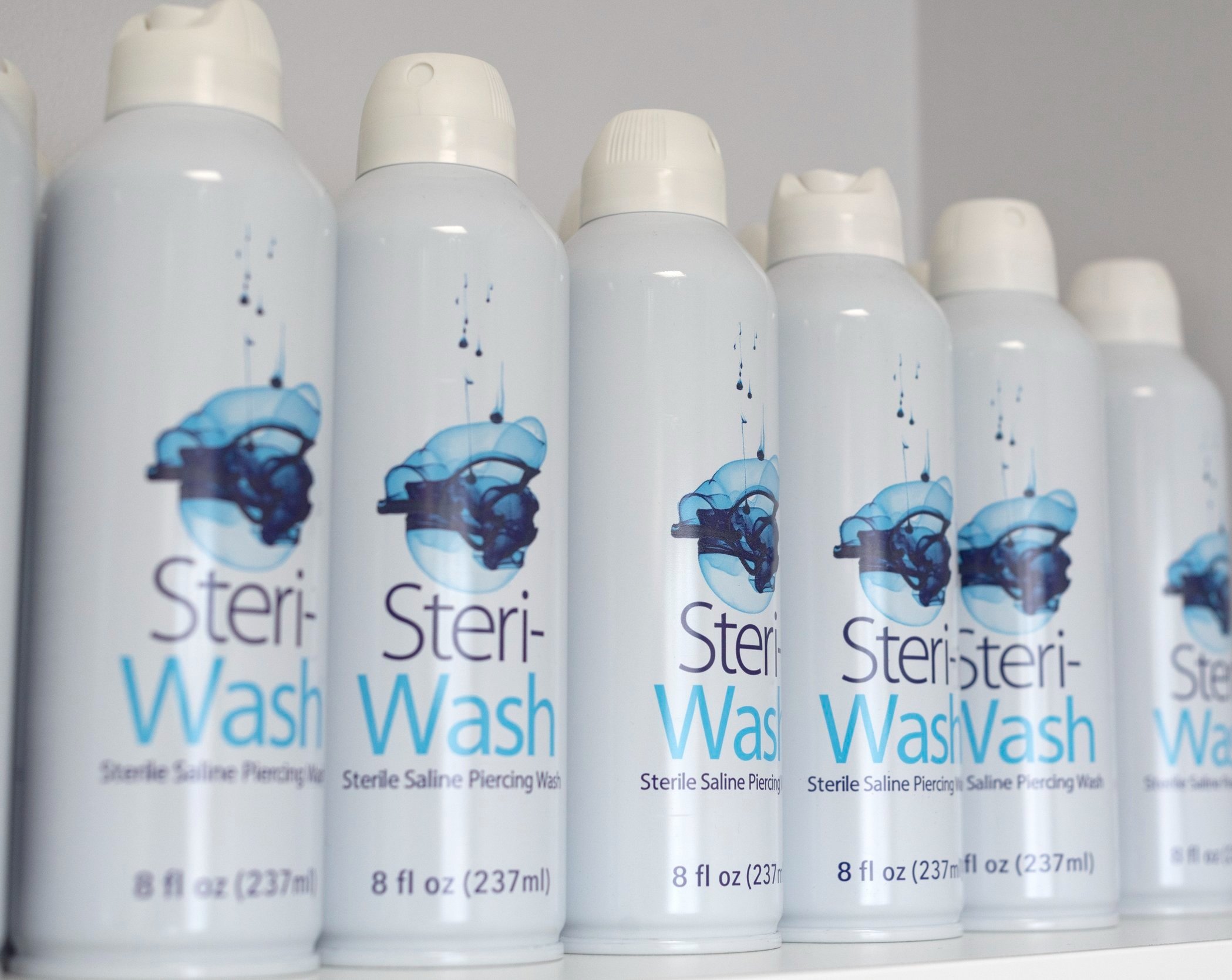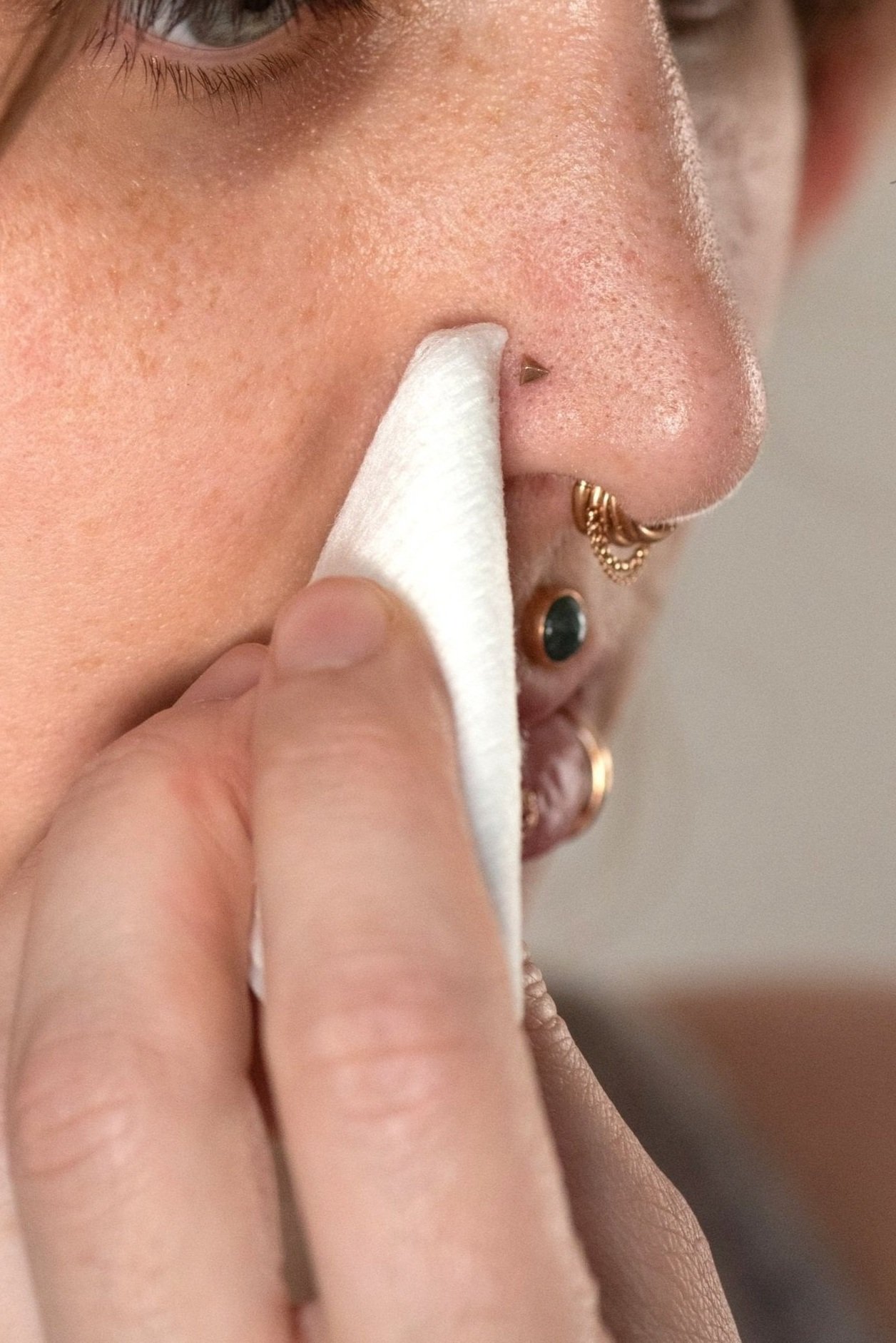Healing and Aftercare
BASICs of PIERCING AFTERCARE
Piercing aftercare aims to prevent the accumulation and hardening of the discharge produced by your body during the healing process. This hardened discharge, often referred to as "crusties," can gather and lead to problems like causing your jewelry to fit incorrectly, irritating the healing piercing, or causing discomfort if it's pulled into the piercing channel.
To effectively manage this, it's recommended to check your piercing each day to see if there are any crusties around the piercing. If you notice crust or discharge, do these steps to clean:
• Gently spray sterile saline solution onto all sides of your piercing
• Spray sterile saline solution onto a corner of unwoven gauze, clean paper towel, or a q-tip. Gently clean around the piercing on each side to remove the crusties.
• Carefully pat the area dry using unwoven gauze, a clean paper towel, or a hair dryer on the cool setting.
If you don't see any crusties, your piercing is likely happy, healthy, and healing well! In this case, there is no need to additionally clean the piercing.
In the event that you notice hardened-on buildup, a warm shower can help by softening the crusts. Letting the water flow over the piercing can aid in this process. After your shower, you can use saline spray to rinse away the softened crusties. If the buildup proves resistant, consult your piercer to determine if a more assertive approach is necessary. Piercings don’t like being handled aggressively so striking a balance between gentle care and forceful removal is key – remember to avoid picking at scabs but do attend to built up discharge.
For oral piercings, apply the same technique externally. Additionally, maintain oral hygiene by rinsing the inside of your mouth with bottled water after eating, drinking, or smoking. Incorporate rinsing with an alcohol-free mouthwash up to twice daily to support the healing process.
Please read the rest of this page and the aftercare brochure you receive at your appointment to learn all the best practices in caring for your new piercing!
Need more saline? Click below to purchase it from our web store or you can find it in the wound care section of any pharmacy!
WHAT'S NORMAL?
Swelling, redness, tenderness, some bleeding, and some bruising is normal for a fresh piercing. As it heals the piercing will have a whiteish/beige discharge which is not pus, and should not be picked off the piercing. As it heals the discharge will become less and less noticeable.
Your piercing will feel healed much earlier than it will truly be healed, as the body heals from the outside in. Please do not change your jewelry earlier than recommended, or leave the piercing without jewelry, because it can close very quickly!
GENITAL PIERCINGS
Free bleeding is possible with genital piercings (especially Prince Albert piercings), so take care when selecting underwear and bed sheets for the week following your piercing.
You may resume sexual activity whenever you are ready, but be sure to use a barrier for the first 4-6 weeks. Even if you're not concerned with STI's, bacteria from another person's body can likely cause issues with a healing piercing. This includes saliva!
CHANGING JEWELRY
Changing jewelry in healing piercings can cause irritation in the piercing channel, and even lead to the piercing closing. We advise leaving initial jewelry in earlobe piercings for at least 5 months, and for cartilage and other piercings, at least 6-9 months. If your piercing seems irritated by a change it may not be ready and so it’s best to return to your original jewelry and give it longer to heal. Even after piercings are healed, they can close up quite quickly, so we advise having jewelry in at all times to maintain your piercing!

Do’s and Don’ts
-
Do
Stay healthy! Get a good night’s sleep, stay hydrated, eat well and avoid stress. Taking care of yourself makes it easier for your body to heal.
-
Do
Only wear high quality jewelry. This means 14k-18k solid gold, platinum, implant-grade titanium, implant-grade stainless steel, pure niobium, or glass. Quality isn’t just indicated by materials. Be sure that your jewelry has a smooth wearable surface with a high polish to avoid harboring bacteria.
-
Don't
Don't use any products other than sterile saline or plain water on your piercing. This includes soap, alcohol, makeup, peroxide, sea salt, medicated ointments and tea tree oil. It all can be very irritating for your piercing.
-
DON'T
Don’t just spray the piercing with saline and let it air dry. Saline is not a medicated product, so all that does is make your ear wet. If you are having issues with a piercing, spraying with with saline and letting it air dry is not going to help things and will only make the piercing wet.
-
Don't
Don't play with or rotate your jewelry. Your skin will not stick to your jewelry, and rotating it only will break apart any tissue that is trying to heal inside.
-
Don't
Don't take your jewelry out - piercings can close quickly. Even if it's healed! Play a sport? Having surgery? Come see us to discuss alternative jewelry styles and materials!
-
Don't
Don't submerge your piercing in any body of water, including pools, oceans, lakes, and baths for 6-8 weeks. The chemicals/bacteria in the water can be extremely irritating to the piercing and can cause irritations or infections that could lead to the piercing needing to be removed.
-
Don't
Don't wear costume jewelry or low quality materials such as sterling silver or surgical steel. Even healed piercings can sustain permanent damage from lower quality jewelry.
-
Don't
Do not sleep on your new piercing and avoid helmets, headphones, high-wasited pants or anything else that applies pressure to the piercing.
Downsizing
This is a very important part of the healing process! Many fresh piercings require jewelry have a little room to accommodate your initial swelling. Without that extra room the piercing is bound to have issues. After a period of time (6-8 weeks depending on the piercing) your swelling should subside and you can come back for a shorter piece of jewelry to wear for the remainder of healing. Downsizing is important because the additional length on jewelry can cause issues with healing if left in after swelling subsides. Please email us to see if you need a downsize or if your piercing is ready for a shorter post!
Healing Times
Healing times for piercings can vary depending on a variety of factors such as lifestyle, health, stress, nutrition and whether the piercing has been slept on or traumatized. The time frames given here are just estimates and not a guarantee that your piercing will be healed during that period. If you’re wanting to change your jewelry or leave your piercing without jewelry in it we always recommend checking with your piercer before doing so.
Ear Piercings
-
Typically take around 6 months to heal and may or may not need a downsize around 6-8 weeks. Check in with a piercer to see if your lobes need shorter posts!
-
These piercings take about 9 months to heal and will need a downsize at 6-8 weeks!
-
These piercings take about 9 months to heal and will need a downsize at 6-8 weeks!
-
These piercings take about 9 months to heal and will need a downsize at 4-8 weeks!
-
These piercings take about 9 months to heal and will need a downsize at 8-12 weeks!
-
These piercings will take around 9-12 months to heal and will not need to be downsized during the healing period.
-
These piercings take about 9 months to heal and will need a downsize at 12-16 weeks!
-
These piercings take around 9-12 months to heal and will not need a downsize during the healing process!
Facial Piercings
-
These piercings take about 9 months to heal and will need a downsize at 6-8 weeks!
-
These piercings take around 6 months to heal and will not need a downsize during the healing period.
-
These piercings take about 6 months to heal. To prevent damage to teeth and gums, they will need a downsize at 3-6 weeks and potentially once again after 2-3 months!
-
These piercings take around 6 months to heal and may or may not need a downsize. Check in with your piercer around 6-8 weeks to confirm!
-
These piercings take 6-9 months to heal and will need a downsize at 6-8 weeks!
Body Piercings
-
These piercings take about 9 months to heal and don’t typically need a downsize during the healing period!
-
These piercings take about 9 months to heal and don’t typically need a downsize during the healing period!
-
These piercings take around 9 months to heal and typically are not downsized during the healing process.
Genital Piercings
-
These piercings take about 3-4 months to heal and don’t typically need a downsize during the healing period.
-
These piercings take about 6-9 months to heal and don’t typically need a downsize during the healing period.
-
These piercings take about 2-4 months to heal and don’t typically need a downsize during the healing period.
-
These piercings take about 6-8 months to heal and don’t typically need a downsize during the healing period.
-
These piercings take about 6-9 months to heal and don’t typically need a downsize during the healing period.
-
These piercings take about 3-4 months to heal and don’t typically need a downsize during the healing period.
-
These piercings take about 6 months to heal and don’t typically need a downsize during the healing period.
-
These piercings take about 4-6 months to heal and don’t typically need a downsize during the healing period.
-
These piercings take about 4-6 months to heal and don’t typically need a downsize during the healing period.
-
These piercings take about 6-9 months to heal and don’t typically need a downsize during the healing period.
-
These piercings take about 6-9 months to heal and don’t typically need a downsize during the healing period.
We do everything possible during your appointment to set you up for a successful piercing. Once you leave the studio it is your responsibility to take care of your body and your piercing! If you have questions about your piercing or are having problems with your piercing please reach out to us ASAP or book a troubleshooting appointment so that we can help you get back on track.




